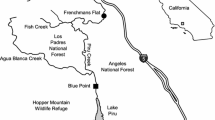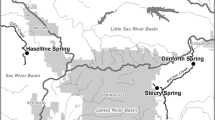Abstract
The South American floating aquatic plant water hyacinth (Eichhornia crassipes) has a history of worldwide invasions, including a 1904 introduction into the Sacramento-San Joaquin Delta, California. The native pennywort (Hydrocotyle umbellata) occupies similar habitats in the Delta and is extensively used by resident invertebrates and fish. We sought to discover if an invader would be functionally equivalent to the native plant, by asking whether the encroadhing hyacinth modified the invertebrate assemblage structure and fish-invertebrate food web relative to pennywort. We sampled epiphytic, epibenthic, and benthic invertebrates, and plant canopy insects in patches of hyacinth and pennywort, and analyzed fish diets at three sites in the Delta during 1998. We also measured habitat structure (leaf density, root biomass, and surface area). In 1999, following control and absence of hyacinth, we again measured epiphytic invertebrates in pennywort. We found differences between hyacinth and pennywort in structure, associated invertebrates, and fish diets. Most measurements inferred functional non-equivalency between hyacinth and pennywort, although some functional equivalency and natural variation existed. Leaf and insect densities were significantly higher in pennywort and there were also significant differences in insect assemblage compositions. Hyacinth roots in the water column had significantly more surface area. Densities of epibenthic and benthic aquatic invertebrates were typically greater in pennywort and taxonomic compositions of aquatic invertebrate assemblages showed significant differences. Amphipods and isopods living epiphytically in the root masses were particularly abundant, including several newly discovered introduced species: the amphipodCrangonyx floridanus and the isopodsCaecidotea racovitai andAsellus hilgendorfii. The native amphipodHyalella azteca was more abundant in pennywort and heavily preyed upon by fish, while the non-indigenousC. floridanus was more abundant in hyacinth and not prevalent in fish diets. The introduction of hyacinth to the Delta has caused significant ecological alterations in the surrounding community, due to hyacinth being functionally different from native patches of pennywort.
Similar content being viewed by others
Literature Cited
Ashton, P. J. andD. S. Mitchell. 1989. Aquatic plants: Patterns and modes of invasion, attributes of invading species and assessment of control programmes, p. 111–154.In J. A. Drake and H. A. Mooney (eds.) Biological Invasions, A Global Perspective. Scope 37. John Wiley and Sons, Chichester, New York.
Bailey, R. G. andM. R. Litterick. 1993. The macroinvertebrate fauna of water hyacinth fringes in the Sudd swamps (River Nile, southern Sudan).Hydrobiologia 250:97–103.
Barret, S. C. H. 1989. Waterweed invasions.Scientific American 261:90–97.
Bowman, T. E.. 1974. The Californian freshwater isopod,Asellus tomalensis, rediscovered and compared withAsellus occidentalis.Hydrobiologia 44:431–441.
Brown, L. R. andP. B. Moyle. 1991. Changes in habitat and microhabitat partitioning within an assemblage of stream fishes in response to predation by Sacramento squawfish (Ptychocheilus grandis)Canadian Journal of Fisheries and Aquatic Sciences 48:849–856.
California Department of Boating and Waterways (CDBW). 1998. 1998 Summary of Operations Waterhyacinth Chemical Control Program. CDBW, Sacramento, California.
California Department of Water Resources (CDWR). 1993. The Sacramento/San Joaquin Delta Atlas. CDWR, Sacramento, California.
Cohen, A. N. andJ. T. Carlton. 1995. Nonindigenous aquatic species in a United States estuary: A case study of the biological invasions of the San Francisco Bay and Delta. A report for the U.S. Fish and Wildlife Service and the National Sea Grant College Program. University of California at Berkeley, Williams College-Mystic Seaport, Berkeley, California.
Cohen, A. N. andJ. T. Carlton. 1998. Accelerating invasion rate in a highly invaded estuary.Science 279:555–558.
Crooks, J. A. andH. S. Khim. 1999. Architectural vs. biological effects of a habitat-altering, exotic mussel,Musculista senhousia.Journal of Experimentals Marine Biology and Ecology 240:53–75.
Crowder, L. B. andW. E. Cooper. 1982. Habitat structural complexity and the interaction between bluegills and their prey.Ecology 63:1802–1813.
Dibble, E. D., K. J. Killgore, andG. O. Dick. 1996. Measurements of plant architecture in seven aquatic plants.Journal of Freshwater Ecology 11:311–318.
Drake, J. A. andH. A. Mooney (eds.). 1989. Biological Invasions: A Global Perspective. Scope 37. John Wiley and Sons, Chichester, New York.
Finlayson, B. J. 1983. Water hyacinth: Threat to the Delta?Outdoor California 44:10–14.
Galatowitsch, S. M., N. O. Anderson, andP. D. Ascher. 1999 Invasiveness in wetland plants in temperate North America.Wetlands 19:733–755.
Gopal, B. 1987. Aquatic Plant Studies 1. Water Hyacinth. Elsevier Publishing, New York.
Harrod, J. J. andR. E. Hall. 1962. A method for determining the surface areas of various aquatic plants.Hydrobiologia 20: 173–178.
Henry, J. P. andG. Magniez. 1995. Nouvelles données sur les Asellidae épigés d'Extrême-Orient (Crustacea, Isopoda, Asellota).Contributions to Zoology 65:101–122.
Holsinger, J. R. 1972. Biota of Freshwater Systems, Identification Manual No. 5. The Freshwater amphipod crustaceans (Gammatidae) of North America. Environmental Protection Agency. Washington, D.C.
Hurlbert, S. H. 1978. The measurement of niche overlap and some relatives.Ecology 59:67–77.
Hymanson, Z., D. Mayer, andJ. Steinbeck. 1994. Long-term trends in benthos abundance and persistence in the upper Sacramento-San Joaquin estuary, summary report: 1980–1990. Technical Report 38 (FWQ/BIO/IATR/94-38). Interagency Ecological Program for the San Francisco Bay/Delta Estuary, California Department of Water Resources, Sacramento, California.
Ivlev, V. S. 1961. Experimental Ecology of the Feeding of Fishes. Translated from Russians. Yale University Press, New Haven, Connecticut.
Jantrarotai, P. 1990. Water hyacinth (Eichornia crassipes) and water pennywort (Hydrocotyle ranunculodies) use in treatment of poultry wastewater. Ph.D. Dissertations, Auburn University, Auburn, Alabama.
Jones, C. G., J. H. Lawton, andM. Chachak. 1997. Positive and negative effects of organisms as physical ecosystem engineers.Ecology 78:1946–1957.
Kline, J. L. andB. M. Wood. 1996. Food habitat and diet selectivity of the brown bulhead.Journal of Freshwater Ecology 11: 145–151.
Lechowicz, M. J. 1982. The sampling characteristics of electivity indices.Oecologia 52:22–30.
Levings, C. D., D. E. Boyle, andT. R. Whitehouse. 1995. Distribution and feeding of juvenile Pacific salmon in freshwater tidal creeks of the lower Fraser River, British Columbia.Fisheries Management and Ecology 2:299–308.
Madsen, J. D. 1997. Methods for management of nonindigenous aquatic plants, p 145–171.In J. O. Luken and J. W. Thieret (eds.), Assessment and Management of Plant Invasions. Springer, New York.
Magniel, G. andJ. Toft. 2000. Présence d'un Asellide épigé originaire d'Extrême-Orient en Californie.Bulletin mensuel de la Société Linnéene de Lyon 69:127–132.
Masifwa, W. F., T. Twongo, andP. Denny. 2001. The impact of water hyacinth,Eichhornia crassipes (Mart) Solms on the abundance and diversity of aquatic macroinvertebrates along the shores of northern Lake Victoria, Uganda.Hydrobiologia 452:79–88.
Nagasawa, K., S. Egusa, T. Hara, andI. Yagisawa. 1983. Ecological factors influencing the infection levels of salmonids byAcanthocephalus opsariichthydis (Acanthocephala: Echinorhynchidae) in Lake Yunoko, Japan.Fish Pathology 18:53–60.
Nichols, F. H., J. E. Cloern, S. N. Luoma, andD. H. Peterson. 1986. The modifications of an estuary.Science 231:567–573.
Parker, I. M., D. Simberloff, W. M. Lonsdale, K. Goodell, M. Wonham, P. M. Kareiva, M. H. Williamson, B. Von Holle, P. B. Moyle, J. E. Byers, andL. Goldwasser. 1999. Impact: Toward a framework for understanding the ecological effects of invaders.Biological Invasions 1:3–19.
Pinkas, L., M. S. Oliphant, andI. L. K. Iverson. 1971. Food habits of albacore, bluefin tuna, and bonito in California water.California Department of Fish and Game Fish Bulletin 152:1–105.
Rozas, L. P. andT. J. Minello. 1997. Estimating densities of small fishes and decapod crustaceans in shallow estuarine habitats: A review of sampling design with focus on gear selection.Estuaries 20:199–213.
Ruesink, J. L., I. M. Parker, M. J. Groom, andP. M. Kareiva. 1995. Reducing the risks of nonindigenous species introductions: Guilty until proven innocent.Bioscience 45:465–477.
Schramm, H. L. andK. J. Jirka. 1989. Epiphytic macroinvertebrates as a food resource for bluegills in Florida Lakes.Transactions of the American Fisheries Society 118:416–426.
Schramm, H. L., K. J. Jirka, andM. V. Hoyer. 1987. Epiphytic macroinvertebrates on dominant macrophytes in two central Florida Lakes.Journal of Freshwater Ecology 4:151–161.
Simberloff, D. 1991. Keystone species and community effects of biological introductions, p. 1–19.In L. R. Ginzburg (ed.), Assessing Ecological Risks of Biotechnology. Butter worth-Heinemann, Boston, Massachusetts.
Simenstad, C. A., C. D. Tanner, R. M. Thom, andL. L. Conquest. 1991. Estuarine habitat assessment protocol. U.S. Environmental Protection Agency, Seattle, Washington.
Simenstad, C. A. andR. M. Thom. 1996. Functional equivalency trajectories of the restored Gog-Le-Hi-Te estuarine wetland.Ecological Applications 6:38–56.
Stromberg, J. C. 1998. Functional equivalency of saltcedar (Tamarix chinensis) and fremont cottonwood (Populus fremontii) along a free-flowing river.Wetlands 18:675–686.
Sutherland, W. J. 1996. Ecological Census Techniques: A Handbook. Cambridge University Press, New York.
Terry, C. 1977. Stomach contents methodology: Still lots of questions, p. 87–92.In C. A. Simenstad and S. J. Lipovsky (eds.) Fish Food Habits Studies, Proceedings 1st Pacific Northwest Technical Workshop, 13–15 October 1976, Astoria, Oregon. Washington Sea Grant WSG-WO-77-2, Seattle, Washington.
The Bay Institute (TBI). 1998. From the Sierra to the Sea: The Ecological History of the San Francisco Bay-Delta Watershed. The Bay Institute, San Francisco, California.
Toft, J. D., J. C. Cordell, andW. C. Fields. 2002. New records of crustaceans (amphipoda, isopoda) in the Sacramento/San Joaquin Delta, California and application of criteria for introduced species.Journal of Crustancean Biology 22:200–210.
U.S. Army Corps of Engineers (USCOE) 1985. Waterhyacinth, Sacramento-San Joaquin Delta, California. State Design Memorandum Report. USCOE, Sacramento, California.
Vitousek, P. M. 1986. Biological invasions and ecosystem properties, can species make a difference?, p. 163–176.In H. A. Mooney and J. A. Drake (eds.), Ecology of Biological Invasions of North America and Hawaii. Springer-Verlag, New York.
Werner, E. E., andD. J. Hall 1979. Foraging efficiency and habitat switching in competing sunfishes.Ecology 60:256–264.
Westman, W. E. 1990. Park management of exotic plant species: Problems and issues.Conservation Biology 4:251–260.
Williams, S. L. andC. A. Davis. 1996. Population genetic analyses of transplanted eelgrass (Zostera marina) beds reveal reduced genetic diversity in Southern California.Restoration Ecology 4:163–180.
Williams, W. D. 1970. A revision of North American epigean species ofAsellus (Crustacea: Isopoda).Smithsonian Contributions to Zoology 49:1–80.
Wolverton, B. C. andR. C. McDonald. 1978. Waterhyacinth (Eichhornia crassipes) productivity and harvesting studies.Economic Botany 33:1–10.
Zar, J. H. 1996. Biostatistical Analysis, 3rd edition. Prentice Hall, New Jersey.
Zhang, J. 1997. Systematics of the freshwater amphipod genusCrangonyx (Crangonyctidae) in North America. Ph.D. Dissertation, Old Dominion University, Norfolk, Virginia.
Author information
Authors and Affiliations
Corresponding author
Rights and permissions
About this article
Cite this article
Toft, J.D., Simenstad, C.A., Cordell, J.R. et al. The effects of introduced water hyacinth on habitat structure, invertebrate assemblages, and fish diets. Estuaries 26, 746–758 (2003). https://doi.org/10.1007/BF02711985
Received:
Revised:
Accepted:
Issue Date:
DOI: https://doi.org/10.1007/BF02711985




